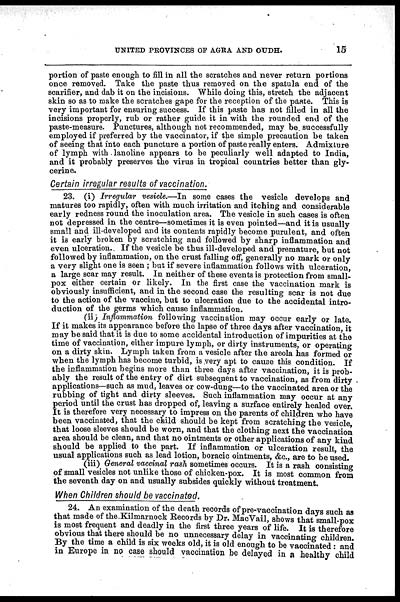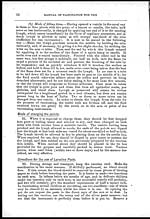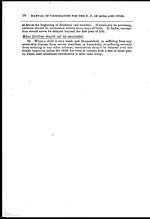Medicine - Vaccination > 1903 - Manual of vaccination for the United Provinces of Agra and Oudh > Manual of vaccination for the United Provinces of Agra and Oudh
(27) Page 15
Download files
Individual page:
Thumbnail gallery: Grid view | List view

UNITED PROVINCES OF AGRA AND OUDH. 15
portion of paste enough to fill in all the scratches and never return portions
once removed. Take the paste thus removed on the spatula end of the
scarifier, and dab it on the incisions. While doing this, stretch the adjacent
skin so as to make the scratches gape for the reception of the paste. This is
very important for ensuring success. If this paste has not filled in all the
incisions properly, rub or rather guide it in with the rounded end of the
paste-measure. Punctures, although not recommended, may be successfully
employed if preferred by the vaccinator, if the simple precaution be taken
of seeing that into each puncture a portion of paste really enters. Admixture
of lymph with lanoline appears to be peculiarly well adapted to India,
and it probably preserves the virus in tropical countries better than gly-
cerine.
Certain irregular results of vaccination.
23. (i) Irregular vesicle.—In some cases the vesicle develops and
matures too rapidly, often with much irritation and itching and considerable
early redness round the inoculation area. The vesicle in such cases is often
not depressed in the centre—sometimes it is even pointed—and it is usually
small and ill-developed and its contents rapidly become purulent, and often
it is early broken by scratching and followed by sharp inflammation and
even ulceration. If the vesicle be thus ill-developed and premature, but not
followed by inflammation, on the crust falling off, generally no mark or only
a very slight one is seen ; but if severe inflammation follows with ulceration,
a large scar may result. In neither of these events is protection from small-
pox either certain or likely. In the first case the vaccination mark is
obviously insufficient, and in the second case the resulting scar is not due
to the action of the vaccine, but to ulceration due to the accidental intro-
duction of the germs which cause inflammation.
(ii) Inflammation following vaccination may occur early or late.
If it makes its appearance before the lapse of three days after vaccination, it
may be said that it is due to some accidental introduction of impurities at the
time of vaccination, either impure lymph, or dirty instruments, or operating
on a dirty skin. Lymph taken from a vesicle after the areola has formed or
when the lymph has become turbid, is very apt to cause this condition. If
the inflammation begins more than three days after vaccination, it is prob-
ably the result of the entry of dirt subsequent to vaccination, as from dirty
applications—such as mud, leaves or cow-dung—to the vaccinated area or the
rubbing of tight and dirty sleeves. Such inflammation may occur at any
period until the crust has dropped of, leaving a surface entirely healed over.
It is therefore very necessary to impress on the parents of children who have
been vaccinated, that the child should be kept from scratching the vesicle
that loose sleeves should be worn, and that the clothing next the vaccination
area should be clean, and that no ointments or other applications of any kind
should be applied to the part. If inflammation or ulceration result, the
usual applications such as lead lotion, boracic ointments, &c., are to be used,
(iii) General vaccinal rash sometimes occurs. It is a rash consisting
of small vesicles not unlike those of chicken-pox. It is most common from
the seventh day on and usually subsides quickly without treatment
When Children should be vaccinated.
24. An examination of the death records of pre-vaccination days such as
that made of the Kilmarnock Records by Dr. MacVail, shows that small-pox
is most frequent and deadly in the first three years of life. It is therefore
obvious that there should be no unnecessary delay in vaccinating children.
By the time a child is six weeks old, it is old enough to be vaccinated: and
in Europe in no case should vaccination be delayed in a healthy child
Set display mode to: Large image | Zoom image | Transcription
Images and transcriptions on this page, including medium image downloads, may be used under the Creative Commons Attribution 4.0 International Licence unless otherwise stated. ![]()
| India Papers > Medicine - Vaccination > Manual of vaccination for the United Provinces of Agra and Oudh > Manual of vaccination for the United Provinces of Agra and Oudh > (27) Page 15 |
|---|
| Permanent URL | https://digital.nls.uk/90721516 |
|---|




